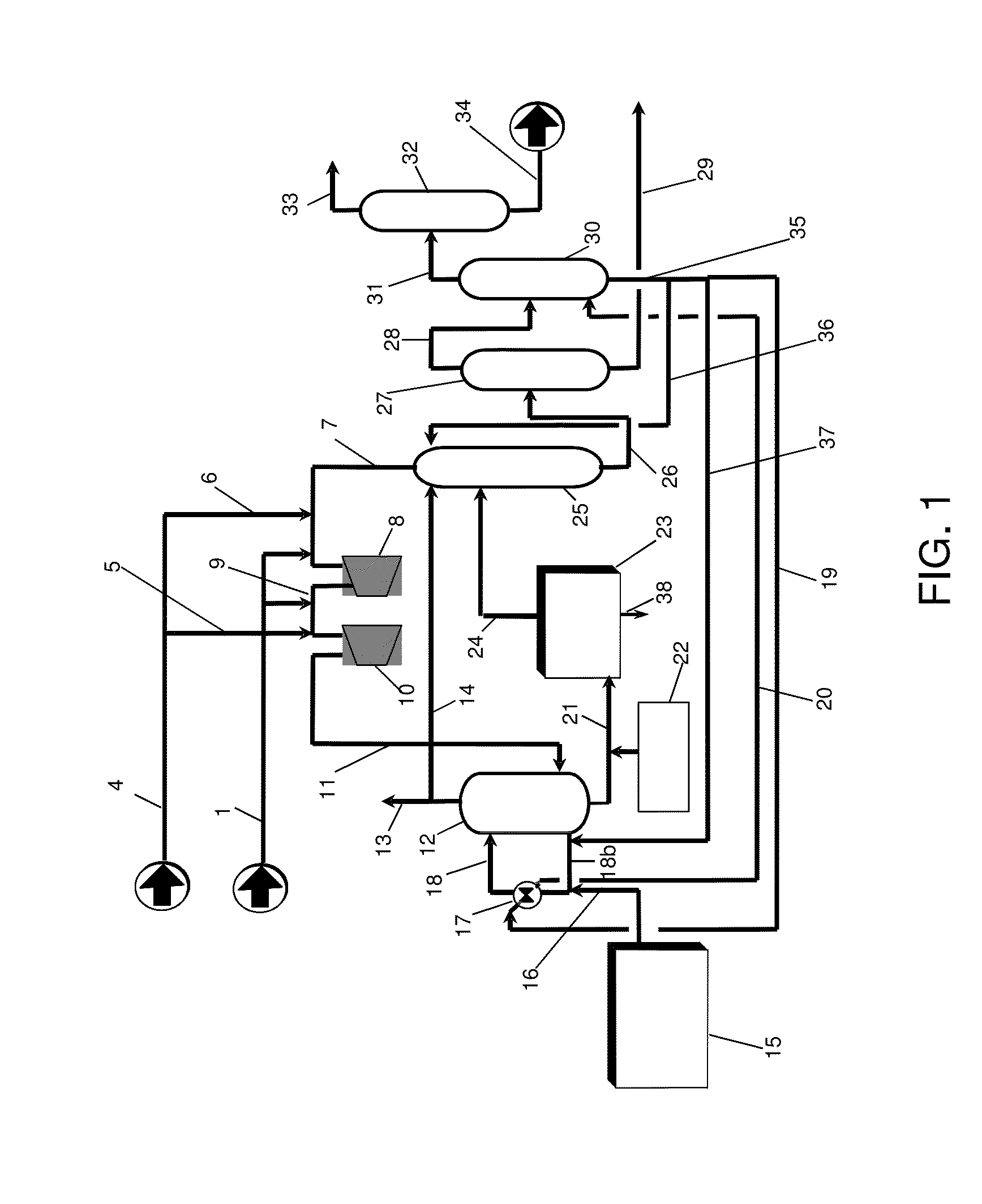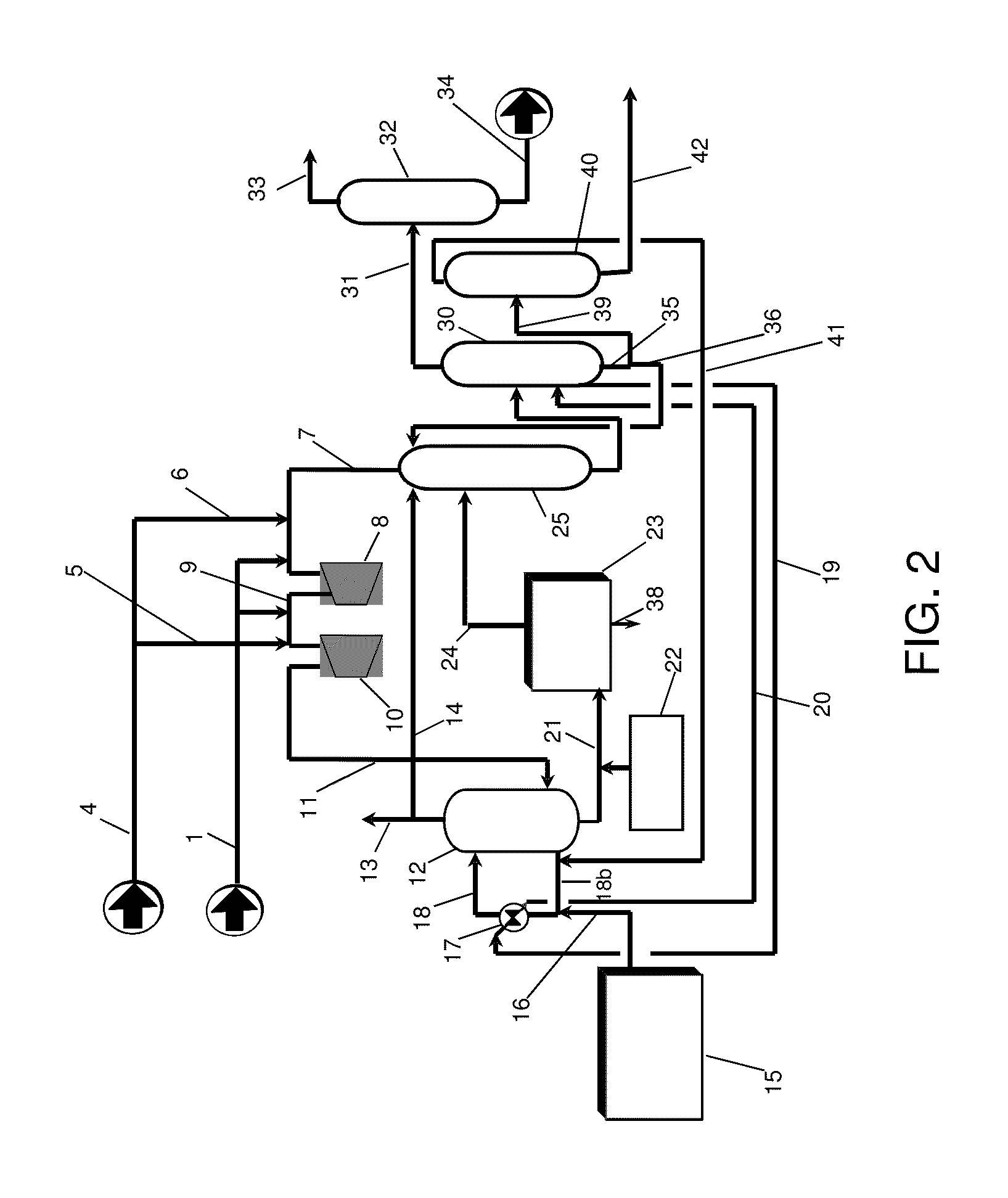Process for separating 1-hexene from a mixture of products obtained from an ethylene trimerization zone
a technology of ethylene trimerization and process, which is applied in the field of production of 1hexene, can solve the problems of energy efficiency, process disadvantage, and efficiency in the selectivity of separation of processes proposed in the prior ar
- Summary
- Abstract
- Description
- Claims
- Application Information
AI Technical Summary
Benefits of technology
Problems solved by technology
Method used
Image
Examples
example 1 (
in Accordance with the Invention)
[0079]The process layout used was that of FIG. 1.
[0080]The feed 1 used was composed of polymer grade ethylene (i.e. approximately 99.9% ethylene). The catalytic system used in the oligomerization reactor 12 comprised the following elements: chromium tris (2-ethylhexanoate), bis (2,6-diphenylphenoxy) magnesium, and triethylaluminium in the following molar proportions: 1 / 1 / 3. The inhibitor used was 2-ethylhexanol. These constituent elements of the catalyst were brought into contact in dry, deaerated cyclohexane (solvent). The reactor was operated at 135° C. and at the bubble point. The reactor temperature was kept constant. The heat of the reaction was eliminated via the recycle loop 18, 18b and the exchanger 17 which was used to exchange heat with the recirculation loop 19, 20.
[0081]The column 25 was operated in accordance with rules known to the skilled person so as to separate the residual ethylene from the solvent and the reaction products.
[0082]Th...
example 3 (
in Accordance with the Invention)
[0093]The process used differed from that of Example 1 in that the solvent used was 2,2-dimethylpentane.
[0094]The column 25 was operated in accordance with rules known to the skilled person so as to separate the residual ethylene from the solvent and the reaction products.
[0095]The column 27 was operated at a pressure of 0.23 MPa at the column top, a column top temperature of 107° C. and a column bottom temperature of 191° C.
[0096]The column 30 was operated with a column top temperature of 76° C. and a column bottom temperature of 108° C. The column top pressure was 0.15 MPa.
[0097]The column 32 was operated at a pressure of 1.06 MPa at the column top, a column top temperature of 73° C. and a column bottom temperature of 165° C.
[0098]After separation in the columns 25, 27, 30 and 32, 0.86 tonnes of 1-hexene (34), 0.015 tonnes of a cut which was rich in 1-butene (33) and 0.066 tonnes of a C8+ cut (29) per tonne of ethylene introduced via the line were ...
example 5 (
in Accordance with the Invention)
[0106]The process layout used was that of FIG. 1.
[0107]The feed 1 used was composed of polymer grade ethylene (i.e. approximately 99.9% ethylene). The catalytic system used in the oligomerization reactor 12 comprised the following elements: chromium tris (2-ethylhexanoate), bis (2-tertbutyl-6-phenylphenoxy) magnesium, and triethylaluminium in the following molar proportions: 1 / 1 / 3. The inhibitor used was 2-ethylhexanol. These constituent elements of the catalyst were introduced into dry, deaerated cyclohexane (solvent). The reactor was operated at 135° C. and at the bubble point. The reactor temperature was kept constant. The heat of the reaction was eliminated via the recycle loop 18, 18b and the exchanger 17 which was used to exchange heat with the recirculation loop 19, 20.
[0108]The column 25 was operated in accordance with rules known to the skilled person so as to separate the residual ethylene from the solvent and the reaction products.
[0109]Th...
PUM
| Property | Measurement | Unit |
|---|---|---|
| pressure | aaaaa | aaaaa |
| temperature | aaaaa | aaaaa |
| temperature | aaaaa | aaaaa |
Abstract
Description
Claims
Application Information
 Login to View More
Login to View More - R&D
- Intellectual Property
- Life Sciences
- Materials
- Tech Scout
- Unparalleled Data Quality
- Higher Quality Content
- 60% Fewer Hallucinations
Browse by: Latest US Patents, China's latest patents, Technical Efficacy Thesaurus, Application Domain, Technology Topic, Popular Technical Reports.
© 2025 PatSnap. All rights reserved.Legal|Privacy policy|Modern Slavery Act Transparency Statement|Sitemap|About US| Contact US: help@patsnap.com


